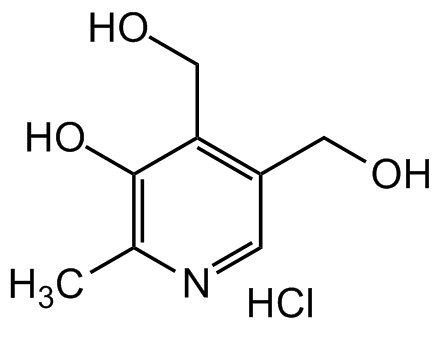Pyridoxine hydrochloride
| Code | Size | Price |
|---|
| CDX-P0466-G025 | 25 g | £48.00 |
Quantity:
| CDX-P0466-G100 | 100 g | £121.00 |
Quantity:
Prices exclude any Taxes / VAT
Overview
Regulatory Status: RUO
Shipping:
AMBIENT
Storage:
Short Term: +4°C, Long Term: -20°C
Images
Documents
Further Information
Alternate Names/Synonyms:
Adermine hydrochloride; Vitamin B6 hydrochloride; Pyridoxol hydrochloride
Appearance:
White to off white powder.
CAS:
58-56-0
EClass:
32160000
Form (Short):
liquid
Handling Advice:
Protect from light and moisture.
Hazards:
H302 - H410
InChi:
InChI=1S/C8H11NO3.ClH/c1-5-8(12)7(4-11)6(3-10)2-9-5;/h2,10-12H,3-4H2,1H3;1H
InChiKey:
ZUFQODAHGAHPFQ-UHFFFAOYSA-N
Long Description:
Chemical. CAS: 58-56-0. Formula: C8H11NO3 . HCl. MW: 205.64. Pyridoxine hydrochloride is the hydrochloride salt form of pyridoxine (vitamin B6), a water-soluble vitamin B. Pyridoxine hydrochloride is converted into the active form, pyridoxal 5'-phosphate (PLP), an essential cofactor in many enzymatic activities including synthesis of amino acids, neurotransmitters and sphingolipids. This vitamin is essential to red blood cell, nervous system, and immune systems functions and helps maintain normal blood glucose levels. It is required for muscle phosphorylase activity associated with glycogen metabolism. Vitamin B6 is essential to maintain the health of nerves, skin and red blood cells. It is also used to treat nerve disorder (peripheral neuropathy) and hereditary disorders like xanthurenic aciduria, cystathioninuria, hyperoxaluria and homocystinuria. It finds application in cosmetics, food and feed additives.
MDL:
MFCD00012807
Molecular Formula:
C8H11NO3 . HCl
Molecular Weight:
205.64
Package Type:
Vial
Precautions:
P273 + P501
Product Description:
Pyridoxine hydrochloride is the hydrochloride salt form of pyridoxine (vitamin B6), a water-soluble vitamin B. Pyridoxine hydrochloride is converted into the active form, pyridoxal 5'-phosphate (PLP), an essential cofactor in many enzymatic activities including synthesis of amino acids, neurotransmitters and sphingolipids. This vitamin is essential to red blood cell, nervous system, and immune systems functions and helps maintain normal blood glucose levels. It is required for muscle phosphorylase activity associated with glycogen metabolism. Vitamin B6 is essential to maintain the health of nerves, skin and red blood cells. It is also used to treat nerve disorder (peripheral neuropathy) and hereditary disorders like xanthurenic aciduria, cystathioninuria, hyperoxaluria and homocystinuria. It finds application in cosmetics, food and feed additives.
Purity:
>98% (HPLC)
SMILES:
OCC1=C(CO)C=NC(C)=C1O.Cl
Solubility Chemicals:
Soluble in water (50mg/ml).
Transportation:
Non-hazardous
UNSPSC Category:
Biochemical Reagents
UNSPSC Number:
12352200
Use & Stability:
Stable for at least 2 years after receipt when stored at -20°C.
References
(1) E.E. Snell; Physiol. Rev. 33, 509 (1953) | (2) M. Ebadi; Neurochem. Int. 3, 181 (1981) | (3) S. Dakshinamurti & K. Dakshinamurti; Can. J. Physiol. Pharmacol. 93, 1083 (2015) (Review) | (4) D. Bueno Dalto & J.-J. Matte; Nutrients 9, 189 (2017) (Review) | (5) N.E.R. Abosamak & V. Gupta; StatPearls (2020)



